Conservatory Plants
If you are blessed with a conservatory or reasonable size greenhouse, then there are many plants you can grow in order to increase both the range and season of fruits and other foods you can produce from your garden. Many of these food plants are also very ornamental and so will fit in very well even in the poshest of conservatories - and can you imagine being able to offer freshly picked exotic fruits to your guests? This leaflet will look at plants that can be grown in pots, either in a greenhouse or conservatory. In general it will deal with plants that are not really hardy outdoors in Britain though, of course, plants that might not be hardy in the colder areas of Scotland may be very at home in the milder areas of the country. We will try and indicate in this leaflet the approximate hardiness of each plant, thus allowing you to decide which species would be most appropriate for your conservatory.
If, due to a lack of garden space, you want to grow hardy plants outdoors in pots then information on this is available in our leaflet The Potted Garden.
There are many hardy herbaceous plants that can also be grown in a conservatory in order to extend their growing season. Thus many people dig up clumps of chives in the autumn, pot them up and grow them indoors for the winter to provide a source of green leaves. Some plants respond well to this treatment, though most will not enjoy it if this should happen to them more than once every few years. This is because they are adapted to growing in a climate with a cold winter when they become dormant. Prevent them from having a dormancy period each year and they will not be very happy about it. How would you like to be deprived of your sleep - especially if you only slept once a year! There are a few temperate plants, however, that will be happy with such treatment, the first that comes to mind is GARLIC CHIVES, Allium tuberosum. This plant will grow on happily for years without being given a rest period and you will benefit from having fresh flavoursome leaves whenever you want them.
There are several conventional fruits that grow very well in conservatory conditions. Although we will not be dealing with them in any detail here, brief details of a few are given below. All of them will benefit from a period of cold weather, so consider putting them outdoors in late autumn until about February.

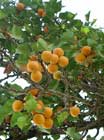

.jpg)
- Prunus persica. PEACHES and NECTARINES do not in general ripen very well when grown outdoors in this country. Give them the protection of a conservatory, though, and they will reward you with a crop of delicious fruits. There are a number of dwarf varieties available that will fit nicely even in smaller areas.
- Prunus armenia. APRICOTS will thrive in the conservatory.
- Vitis vinifera. The very best GRAPES grown in this country are produced in conservatories. It is not really practical to grow this deep-rooted plant in a pot so place the root in the soil just outside the conservatory, make a hole in the wall for the trunk and allow the plant to grow into the conservatory.
- Ficus carica. You can get two or even three crops of FIGS a year from conservatory grown plants.
Cultivation details
Almost all the plants mentioned in this leaflet should grow well in an unheated greenhouse or conservatory providing the temperature does not drop below freezing. Those species that require warmer winter conditions than this will be mentioned in the text. Unless stated otherwise, all the plants will do best in a sunny position with well-drained compost.
Having mentioned compost, I would like to make a few observations on growing plants in pots. Firstly, in our experience it is best to grow most plants in non-soil-based compost. Due to environmental considerations, we do not use peat-based composts or those that use Coir or other tropical products. Instead, we have found several suppliers that produce composts from recycled garden waste. This, in general, gives reasonable results though plants will require supplementary feeding after a few months. A proprietary liquid seaweed feed is ideal for this - if you are more adventurous then you can always make your own liquid feed from Comfrey, nettles or garden weeds. Apply the feed once every one or two weeks throughout the growing season. See our leaflet Vegan Organics - the Basic Principles for more information on this.
If you decide to make your own compost mix, then it is important to remember that when fertile garden soil is put into a pot it behaves in quite a different way to when it was in the garden and seldom gives good results. Should you want to use garden soil then there are a number of ways in which you can improve it. Firstly, make sure it contains good quantities of organic matter such as well-rotted leaf mould or garden compost, since this provides plant foods and also acts to hold moisture in the soil. Secondly, add sharp sand or small gravel to improve drainage and allow more air into the compost.
Water, so essential to life, is the main cause of death in pot-grown plants. We often give too much or too little and either can be fatal. Unless stated otherwise in the text, all the plants listed here have average water requirements. This means that they need considerably more in their growing season and only enough to keep the soil moist in the winter or when they are dormant. In general, do not water a plant until it is nearly dry, but water it before it is completely dry. Be generous in the summer, but be a scrooge in the winter. In the summer it is best to water either in the early morning or late afternoon when the sun is not so hot, but in the winter try to water in the late morning to allow the foliage to dry off before the evening.
Whereas, conventionally, it is usual to grow just one plant in a pot, this is not the only possibility. Indeed, if you wish to follow permaculture practices then you will be looking for ways to grow a number of plants together. One way we have found this to work is by using old bathtubs (these can be made to look quite pretty by putting them into a wooden frame or something similar). You need to seal off the plug hole (since you do not want to have water pouring all over the floor) and then put a layer of grit about 75 - 100mm deep in the bottom of the bath to ensure good drainage. Fill the bath up with good quality compost to within 50mm of the top and then plant out. It is possible to get quite a few plants into each of these baths, especially if you understand basic permaculture principles and ensure you utilize all possible strata.
Thus you could have a small tree planted in the centre with smaller shrubs planted around it. Underneath the shrubs you could grow herbaceous perennials and bulbs with, perhaps, a not too vigorous climbing plant trained into the tree. With careful selection of compatible species it should be possible to grow quite a number of plants in the tub.
Most of the plants listed below prefer a well drained near neutral soil and a sunny position. Those that require different conditions will be noted in the text.
The following list is a small proportion of plants that you could grow in your greenhouse or conservatory, many other species are also possible, though the plants chosen here are amongst the most productive and tasty of the possibilities. They have been arranged according to their growth habit - i.e. herbaceous, evergreen, deciduous.
Herbaceous Plants:
Abelmoschus esculentus
.jpg) OKRA is a fairly well known vegetable and the only annual in this leaflet, though that does not stop it being a rather pretty plant! Growing a metre or more tall, it needs lots of warmth if it is to crop well so it is best to sow the seed in February or March for it to benefit from the summer sun. Give the plant a sunny position, but make sure that it gets lots of moisture - in addition, a daily sprinkling with water or perhaps a very weak liquid feed will keep it happy and increase fruit set. Pretty yellow flowers are produced for much of the summer and these are followed by fairly large seedpods, which are the main edible use of the plant.
OKRA is a fairly well known vegetable and the only annual in this leaflet, though that does not stop it being a rather pretty plant! Growing a metre or more tall, it needs lots of warmth if it is to crop well so it is best to sow the seed in February or March for it to benefit from the summer sun. Give the plant a sunny position, but make sure that it gets lots of moisture - in addition, a daily sprinkling with water or perhaps a very weak liquid feed will keep it happy and increase fruit set. Pretty yellow flowers are produced for much of the summer and these are followed by fairly large seedpods, which are the main edible use of the plant.
The seedpods are picked before they mature, in some varieties they can be 20cm or longer. They are often used as a cooked vegetable and make an excellent thickener in soups and stews. They are particularly nice in a curried dish with rice.
There are several named varieties and we would recommend obtaining 'Clemson's Spineless', 'Emerald Spineless', 'Long Green' or 'Green Velvet' if possible since these are capable of producing crops at lower temperatures than most forms.
Ananas comosus
.jpg) The PINEAPPLE needs more heat, especially in the winter, than any of the other species mentioned here, but it is included because it is such a popular fruit and a fairly easy plant to grow. Give the plant a sunny position and a winter temperature that does not fall below about 15°c, and you should be rewarded with fresh pineapples to eat. The easiest way of obtaining a plant is to buy a pineapple from your greengrocer. Cut off the leafy top and pot it up - it will soon root and form a new plant. Pineapples are so well known that there is no need to describe them here. Suffice it to say that a fruit picked fully ripe from your conservatory is far far nicer than one picked unripe in the tropics and transported to this country.
The PINEAPPLE needs more heat, especially in the winter, than any of the other species mentioned here, but it is included because it is such a popular fruit and a fairly easy plant to grow. Give the plant a sunny position and a winter temperature that does not fall below about 15°c, and you should be rewarded with fresh pineapples to eat. The easiest way of obtaining a plant is to buy a pineapple from your greengrocer. Cut off the leafy top and pot it up - it will soon root and form a new plant. Pineapples are so well known that there is no need to describe them here. Suffice it to say that a fruit picked fully ripe from your conservatory is far far nicer than one picked unripe in the tropics and transported to this country.
Azorina vidalii
.jpg) This plant, growing about 30cm tall and closely related to the Campanulas or HAREBELLS, has deliciously sweet-tasting leaves that can be eaten like lettuce and also make an excellent addition to mixed salads. The flowers have a similar flavour and can be used as a decorative and very tasty garnish to salads. An easy plant to grow in a sunny position, so long as you go very easy on the watering and ensure temperatures do not fall below about 0°c. Keep the plants as dry as possible in the winter (but not dust dry) and water carefully in the summer and you should be rewarded with lots of white or pink flowers in the summer.
This plant, growing about 30cm tall and closely related to the Campanulas or HAREBELLS, has deliciously sweet-tasting leaves that can be eaten like lettuce and also make an excellent addition to mixed salads. The flowers have a similar flavour and can be used as a decorative and very tasty garnish to salads. An easy plant to grow in a sunny position, so long as you go very easy on the watering and ensure temperatures do not fall below about 0°c. Keep the plants as dry as possible in the winter (but not dust dry) and water carefully in the summer and you should be rewarded with lots of white or pink flowers in the summer.
Canna indica and C. edulis
.jpg) CANNAS are quite beautiful when in flower, and also have very decorative leaves which look a little like banana leaves. Growing about 2 metres tall, they will flower for much of the summer if given a sunny position, rich soil and plenty of moisture. Plants can tolerate a few degrees of frost and so are very easy to overwinter, but keep them fairly dry when they are dormant. Cannas are cultivated for their edible root in the Tropics. This root is a rich source of starch which can be used as an arrowroot and is obtained by rasping the root to a pulp, then washing and straining to get rid of the fibres. The very young tubers can also be eaten cooked; they are sweet but rather fibrous.
CANNAS are quite beautiful when in flower, and also have very decorative leaves which look a little like banana leaves. Growing about 2 metres tall, they will flower for much of the summer if given a sunny position, rich soil and plenty of moisture. Plants can tolerate a few degrees of frost and so are very easy to overwinter, but keep them fairly dry when they are dormant. Cannas are cultivated for their edible root in the Tropics. This root is a rich source of starch which can be used as an arrowroot and is obtained by rasping the root to a pulp, then washing and straining to get rid of the fibres. The very young tubers can also be eaten cooked; they are sweet but rather fibrous.
Cymbopogon citratus
.jpg) LEMON GRASS prefers a sunny position in a moisture-retentive soil with plentiful water when in growth and a temperature no lower than about 10°c in the winter, though we have heard reports that it can tolerate the occasional light frost. The plant grows to about 1.5 metres tall. The strongly lemon-scented foliage and stems is much used either fresh or dried as a flavouring in Asian cuisine and is becoming increasingly popular in Britain. The strong lemon flavour makes it particularly nice in sweet and sour dishes. Keep the stored herb separate from other foods since it easily taints them.
LEMON GRASS prefers a sunny position in a moisture-retentive soil with plentiful water when in growth and a temperature no lower than about 10°c in the winter, though we have heard reports that it can tolerate the occasional light frost. The plant grows to about 1.5 metres tall. The strongly lemon-scented foliage and stems is much used either fresh or dried as a flavouring in Asian cuisine and is becoming increasingly popular in Britain. The strong lemon flavour makes it particularly nice in sweet and sour dishes. Keep the stored herb separate from other foods since it easily taints them.
Oxalis species
.jpg) There are many delicate but easily grown little plants in this genus. Given a well-drained soil and a position in full sun or light shade, they will grow away vigorously in the summer and produce a wealth of flowers. If you are growing plants in tubs then these will do very well as edging or ground cover in the tubs.
There are many delicate but easily grown little plants in this genus. Given a well-drained soil and a position in full sun or light shade, they will grow away vigorously in the summer and produce a wealth of flowers. If you are growing plants in tubs then these will do very well as edging or ground cover in the tubs.
All members of the genus have edible leaves and flowers which are more or less acid with a flavour reminiscent of lemons. We find them a delicious addition to salads, using them very much like sorrel.
However, just like sorrel, they need to be eaten in moderation since they can lock up calcium in the diet. If you suffer from rheumatism or other allied diseases then you are well advised to steer completely clear of these plants and any others that contain oxalic acid (this includes sorrel and spinach) since the oxalic acid can aggravate your disease.
Amongst the species we most enjoy are: -
- O. deppei. The iron cross plant produces a fountain of clover-like leaves about 25cm tall and will flower from spring until the autumn. The flowers taste absolutely delicious and the leaves are not far behind. The only problem we have ever had with this plant is getting to see or eat the flowers since our 5-year-old son eats them as soon as he sees them.
- O. megellanica. This is a dainty plant growing no more than 10mm tall but spreading quite freely to cover the soil. It has tiny leaves and produces dainty white flowers in the summer.
- O. pes-caprae. A weed in warmer climes than ours, coming into growth in the autumn and becoming dormant in the summer. The bright yellow flowers are produced in abundance in the spring.
- O. triangularis. One of the most ornamental plants in the genus with dark purple heart-shaped leaves and light pink flowers.
Ullucus tuberosus
 Ullucu is a trailing plant with thick fleshy leaves. It prefers a sunny position and a well-drained but humus-rich soil. Plants are tolerant of light frosts. Either grow it in a wide pot or use it as a ground cover plant in a large tub of other plants since this will allow it to produce more tubers from the leaf axils. This South American species is cultivated for its edible tubers in its native lands. These small tubers, up to 75mm in diameter, come in various colours with reds being dominant. As well as looking very pretty, these starch-rich tubers also have a nice flavour somewhat similar to a waxy potato and can be used in all the ways that potatoes are used.
Ullucu is a trailing plant with thick fleshy leaves. It prefers a sunny position and a well-drained but humus-rich soil. Plants are tolerant of light frosts. Either grow it in a wide pot or use it as a ground cover plant in a large tub of other plants since this will allow it to produce more tubers from the leaf axils. This South American species is cultivated for its edible tubers in its native lands. These small tubers, up to 75mm in diameter, come in various colours with reds being dominant. As well as looking very pretty, these starch-rich tubers also have a nice flavour somewhat similar to a waxy potato and can be used in all the ways that potatoes are used.
Deciduous Shrubs:
Hibiscus rosa sinensis
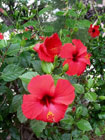 Given a sunny, draught-free position and a very well drained rich soil, this plant should thrive in the conservatory, growing to about 2.5 metres tall and flowering for much of the summer. A very ornamental plant, there are many named forms that have been selected for their beautiful flowers. Any of these named forms can be used.
Given a sunny, draught-free position and a very well drained rich soil, this plant should thrive in the conservatory, growing to about 2.5 metres tall and flowering for much of the summer. A very ornamental plant, there are many named forms that have been selected for their beautiful flowers. Any of these named forms can be used.
The large red flowers are up to 20cm across. Each individual flower only lives for one or two days but plenty of flowers are produced over a period of weeks. The mild-flavoured flowers can be eaten raw or cooked and can also be made into a kind of pickle or used as a purple dye for colouring foods such as preserved fruits and cooked vegetables The young leaves are also edible and can be cooked as a spinach substitute.
All other members of this genus produce more or less edible flowers and leaves. Perhaps the next best one to obtain for the conservatory would be H. sabdariffa, a shrub growing to about 3 metres. The fresh calyx (the outer whorl of the flowers) is used in salads, jellies, soups, sauces, pickles, puddings etc. It is rich in acid and pectin and so is useful for making jellies, and is also used to add colour and flavour to herb teas. A refreshing beverage can be made by boiling the calyx, sweetening it with sugar and adding ginger.
If you live in colder parts of the country where the first autumn frosts arrive in October, or even earlier, then you might consider growing H. syriacus in pots. Whilst the plant is hardy to about -20°c, it flowers in the autumn and needs a nice warm period at this time if it is to do well. If you grow it outdoors in a pot, and bring it in for those autumn months, you will be rewarded by an abundant display of flowers 5cm or more in diameter. These, the young leaves and the immature seedpods are all edible raw.
Punica granatum
 POMEGRANATES can grow up to 7 metres tall, though 3 metres are more likely in pot plants. Plants require a sunny position and a well-drained soil, being careful not to overwater, especially in the winter. There are a number of varieties, don't be tempted to grow the dwarf form (var nana) since this produces poor quality fruits. Cultivars to look for include 'Wonderful', which produces large red fruits. Pomegranate fruits are about 12cm in diameter. They have a tough outer skin which contains a large quantity of small red fruits. These are very juicy and refreshing. Best eaten raw, they are considered delicious by many people though others do not like the large number of seeds with relatively little fruit pulp. The fruit juice can also be used in soups, sauces, jellies, ice cream, cakes etc.
POMEGRANATES can grow up to 7 metres tall, though 3 metres are more likely in pot plants. Plants require a sunny position and a well-drained soil, being careful not to overwater, especially in the winter. There are a number of varieties, don't be tempted to grow the dwarf form (var nana) since this produces poor quality fruits. Cultivars to look for include 'Wonderful', which produces large red fruits. Pomegranate fruits are about 12cm in diameter. They have a tough outer skin which contains a large quantity of small red fruits. These are very juicy and refreshing. Best eaten raw, they are considered delicious by many people though others do not like the large number of seeds with relatively little fruit pulp. The fruit juice can also be used in soups, sauces, jellies, ice cream, cakes etc.
Solanum muricatum
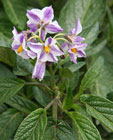 The pepino is cultivated in many sub-tropical and tropical countries for its edible fruit and there are several named varieties, though at the time of writing this leaflet (1999) none were available in Britain. It requires a sunny position and a well-drained soil, though make sure the soil is not too fertile or fruit production will suffer due to excess vegetative growth. Young plants will not tolerate temperatures below about 3°c, though established plants will tolerate the occasional light frost. Plants can set fruit parthenocarpically (without fertilization or seed being formed) but self-fertilization or insect fertilization greatly encourages fruiting.
The pepino is cultivated in many sub-tropical and tropical countries for its edible fruit and there are several named varieties, though at the time of writing this leaflet (1999) none were available in Britain. It requires a sunny position and a well-drained soil, though make sure the soil is not too fertile or fruit production will suffer due to excess vegetative growth. Young plants will not tolerate temperatures below about 3°c, though established plants will tolerate the occasional light frost. Plants can set fruit parthenocarpically (without fertilization or seed being formed) but self-fertilization or insect fertilization greatly encourages fruiting.
The fruit, which can be 10cm long and 6cm wide, is juicy, sweet and aromatic with a very agreeable flavour somewhat like a honeydew melon, though the skin of some varieties has a disagreeable flavour. It should be harvested just before it is fully ripe and will store for several weeks at room temperature.
Stevia rebaudiana
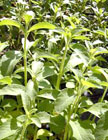 This small shrub, growing about 60cm tall, requires a well-drained sandy soil and a sunny position. It is not very cold tolerant and if you want to keep it happy then do not allow winter temperatures to fall below 5°c.
This small shrub, growing about 60cm tall, requires a well-drained sandy soil and a sunny position. It is not very cold tolerant and if you want to keep it happy then do not allow winter temperatures to fall below 5°c.
The leaves of this plant are quite incredibly sweet with a flavour that is somewhat like liquorice. They make a wonderful sweet tea on their own and can also be used to disguise the flavour of less pleasant medicines. Look out for children though (or adults with a sweet tooth) since these particular members of the human race will soon defoliate a plant and then still pester you to provide more leaves!
Evergreen Shrubs:
Abutilon species
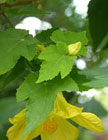 These plants produce some of the tastiest flowers we have ever eaten and, when well grown, will continue to produce these flowers in abundance for many months of the year. Quite one of the most ornamental and easiest of plants that can be grown in a conservatory, just give them a reasonable amount of sun and don't forget to water them! They will tolerate very slight frosts. We just cannot stop eating these flowers - when we can get to them before our 5 year old son that is! They have a mild flavour with a delicious sweetness and a somewhat mucilaginous texture. We tend to pick and eat them straight from the plants but, if you are able to be patient enough, they go really well in a mixed salad.
These plants produce some of the tastiest flowers we have ever eaten and, when well grown, will continue to produce these flowers in abundance for many months of the year. Quite one of the most ornamental and easiest of plants that can be grown in a conservatory, just give them a reasonable amount of sun and don't forget to water them! They will tolerate very slight frosts. We just cannot stop eating these flowers - when we can get to them before our 5 year old son that is! They have a mild flavour with a delicious sweetness and a somewhat mucilaginous texture. We tend to pick and eat them straight from the plants but, if you are able to be patient enough, they go really well in a mixed salad.
There are very many species and cultivars to choose from and there is much more research that needs to be carried out. Of those we have eaten to date we would recommend you try cultivars such as 'Hinton Seedling', 'Canary Bird' and 'Wisley Red' whilst the species A. pictum is also delicious. If you find others that you particularly like then please let us know and we promise not to complain if you send a cutting or three in our direction!
Aloysia triphylla
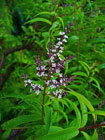 LEMON VERBENA can grow up to 2 metres tall in a conservatory and requires a fertile well-drained soil in a sunny position. A moderately frost-hardy plant, it will tolerate occasional temperatures down to about -10°c. It is very amenable to trimming and can be cut right back to the roots if required - any pruning is best done in the spring. The leaves of lemon verbena have a beautiful strong scent of lemon - just brush against a plant and it will release this delicious scent into the room. Use the leaves to make refreshing drinks that will also have a beneficial effect upon the digestive system, or use them as a flavouring in salads, fruit salads etc.
LEMON VERBENA can grow up to 2 metres tall in a conservatory and requires a fertile well-drained soil in a sunny position. A moderately frost-hardy plant, it will tolerate occasional temperatures down to about -10°c. It is very amenable to trimming and can be cut right back to the roots if required - any pruning is best done in the spring. The leaves of lemon verbena have a beautiful strong scent of lemon - just brush against a plant and it will release this delicious scent into the room. Use the leaves to make refreshing drinks that will also have a beneficial effect upon the digestive system, or use them as a flavouring in salads, fruit salads etc.
Aloe vera
 Growing 70cm or more tall, but spreading considerably further sideways, ALOE VERA requires a very sunny position and well-drained soil. Go very easy when watering this plant, especially in the winter, or you will encourage it to rot. Indeed, plants will tolerate considerable drought but will soon become unhappy in moister conditions. When well grown, the plant will send up a flowering stem 1 metre or more tall and bearing beautiful pink flowers.
Growing 70cm or more tall, but spreading considerably further sideways, ALOE VERA requires a very sunny position and well-drained soil. Go very easy when watering this plant, especially in the winter, or you will encourage it to rot. Indeed, plants will tolerate considerable drought but will soon become unhappy in moister conditions. When well grown, the plant will send up a flowering stem 1 metre or more tall and bearing beautiful pink flowers.
Becoming widely known for its medicinal properties, aloe vera is an ideal first aid plant to grow in the home. Just slice open a leaf and the gelatinous mass exposed is a very soothing and healing substance to rub on the skin in order to treat a wide range of problems including cuts, burns and sunburn.
Carissa macrocarpa
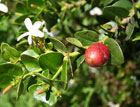 The NATAL PLUM should grow about 2 metres tall in a conservatory and will flower and fruit for most of the year if given a sunny position. Its main problem is that it is rather spiny, so keep it out of harms way if you have young children running about. Plants will tolerate a few degrees of frost so could be tried outdoors in a very sheltered position in the mildest areas of the country.
The NATAL PLUM should grow about 2 metres tall in a conservatory and will flower and fruit for most of the year if given a sunny position. Its main problem is that it is rather spiny, so keep it out of harms way if you have young children running about. Plants will tolerate a few degrees of frost so could be tried outdoors in a very sheltered position in the mildest areas of the country.
When fully ripe, the fruit is black and looks rather like a plum. We have not eaten this fruit as yet, but have been reliably informed that it is sweet and tasty. In its South African homeland it is eaten raw or used to make jellies, pies etc and is also stewed into a sauce that much resembles cranberry sauce.
Citrus species
There is a very large range of citrus fruits that can be grown in a greenhouse or conservatory. For the sake of convenience they will all be listed here, though several of them belong to other genera. All of them need a sunny position and, if good quality fruit is required, a minimum temperature of about 5°c. A compost made up of half loam and half leaf-mould, plus a little charcoal should suit them well and be very careful with the watering - plants will soon look rather sickly if either over or under watered. All of the plants have sweet smelling blossom.
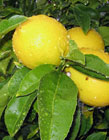
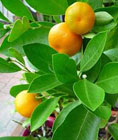
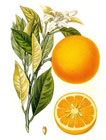

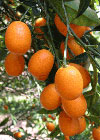
Some of the species you could try include:-
- C. meyeri. MEYER'S LEMON is a fairly hardy plant and can be grown outdoors in a sheltered sunny position in the very mildest areas of the country. The fruit can be up to 15cm long and 7cm wide, it has the true taste of lemons.
- C. reticulata. MANDARINS will tolerate occasional short-lived lows to about -5°c, though fruit quality will be impaired by low temperatures. The fruit is deliciously sweet and much loved by children of all ages.
- C. sinensis. The SWEET ORANGE is widely cultivated for its fruit.
- C. x paradisi. GRAPEFRUITS need a bit more heat than the above species, but will grow well in a conservatory assuming you have the space for a tree 3 metres or more tall.
- Fortunella species. KUMQUATS look like small oranges. Unlike oranges, you eat the whole fruit, skin included. The skin is thin and sweet whilst the fruit is rather acid.
Coccoloba uvifera
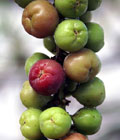 The SEA GRAPE grows up to 3 metres tall in the wild but is very tolerant of trimming and can be kept much smaller in a pot. It requires a high-fertility loam-based soil with added sand for drainage and a very sunny position. The plant prefers a minimum winter temperature around 10°c, though it will tolerate occasional lower temperatures. It has heart-shaped red-veined leaves which make it look particularly attractive.
The SEA GRAPE grows up to 3 metres tall in the wild but is very tolerant of trimming and can be kept much smaller in a pot. It requires a high-fertility loam-based soil with added sand for drainage and a very sunny position. The plant prefers a minimum winter temperature around 10°c, though it will tolerate occasional lower temperatures. It has heart-shaped red-veined leaves which make it look particularly attractive.
The fruit is about 2cm in diameter and is produced in small bunches like grapes. It has an astringent flavour and makes good conserves and jellies.
Cyphomandra betacea
 The TREE TOMATO can grow to 3 metres or more in height. It prefers a sunny position and should do well in any well-drained but fertile soil. Do not forget to water it or it will soon curl up its roots in displeasure! The leaves of this plant are poisonous to eat, and also have a pungent smell, so place it in a position where it will not be brushed against or your conservatory might be filled with a less than pleasant aroma.
The TREE TOMATO can grow to 3 metres or more in height. It prefers a sunny position and should do well in any well-drained but fertile soil. Do not forget to water it or it will soon curl up its roots in displeasure! The leaves of this plant are poisonous to eat, and also have a pungent smell, so place it in a position where it will not be brushed against or your conservatory might be filled with a less than pleasant aroma.
The tree tomato is often cultivated for its edible fruit in sub-tropical and tropical zones, there are some named varieties and fruits are occasionally available for sale in Britain. It requires a minimum winter temperature of 10°c for best fruit production but it is hardy to about -2°c. It will fruit best with a temperature range of 16 - 22°c in the growing season. A very fast growing plant, it starts to fruit within two years from seed and reaches peak production in 3 - 4 years. Trees are, however, short-lived - the life of a commercial plantation is about 8 years.
The fruit, which are 4 - 10cm long and 3 - 5cm wide, can be eaten raw or cooked. The flavour can vary considerably from tree to tree but the best forms are juicy and sub-acid.
Eriobotrya japonica
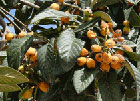 The loquat prefers a fertile well-drained soil in full sun or light shade. Whilst it is hardy to at least -5°c, and can survive occasional temperatures down to between -12 and -17°c, if you want to produce fruit in Britain it is best to grow the plants in a conservatory. This is because trees usually only flower and produce fruit in Britain after a long hot summer and, in addition, they flower in the winter and will not ripen fruit of a satisfactory standard if the winter is cold. Indeed, the fruit is rendered inedible by hard frosts in cold areas. This does mean, though, that you can enjoy their scented flowers during the winter. Loquats are often cultivated for their edible fruit in warm temperate regions and there are more than 800 named cultivars in Japan, though as of 1999 none of these were available in Britain. If you can get hold of it, 'Advance' is a dwarf tree with very juicy fruits.
The loquat prefers a fertile well-drained soil in full sun or light shade. Whilst it is hardy to at least -5°c, and can survive occasional temperatures down to between -12 and -17°c, if you want to produce fruit in Britain it is best to grow the plants in a conservatory. This is because trees usually only flower and produce fruit in Britain after a long hot summer and, in addition, they flower in the winter and will not ripen fruit of a satisfactory standard if the winter is cold. Indeed, the fruit is rendered inedible by hard frosts in cold areas. This does mean, though, that you can enjoy their scented flowers during the winter. Loquats are often cultivated for their edible fruit in warm temperate regions and there are more than 800 named cultivars in Japan, though as of 1999 none of these were available in Britain. If you can get hold of it, 'Advance' is a dwarf tree with very juicy fruits.
The fruit, which is about 4cm in diameter, has a slightly acid, sweet aromatic flavour and can be eaten raw or cooked in pies, sauces, jellies etc. Loquat pie, if made from fruit that is not fully ripe, is said to taste like cherry pie.
Fuchsia species
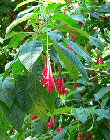 Most people are unaware that all FUCHSIA fruits are edible and, if you choose the right species and cultivars, they are incredibly delicious. Whilst there are many hardy forms that can be grown outdoors, most of the nicest-tasting plants are, unfortunately, not very hardy in this country. However, give them a cooler and partially shaded position in a conservatory and you could be rewarded with excellent crops of fruit. The following are a few of the plants we recommend, but there are many more. Indeed, if you ever find a tasty fuchsia fruit that is not included in this leaflet then we would love to hear from you - and if you would like to also enclose a cutting from the plant.
Most people are unaware that all FUCHSIA fruits are edible and, if you choose the right species and cultivars, they are incredibly delicious. Whilst there are many hardy forms that can be grown outdoors, most of the nicest-tasting plants are, unfortunately, not very hardy in this country. However, give them a cooler and partially shaded position in a conservatory and you could be rewarded with excellent crops of fruit. The following are a few of the plants we recommend, but there are many more. Indeed, if you ever find a tasty fuchsia fruit that is not included in this leaflet then we would love to hear from you - and if you would like to also enclose a cutting from the plant.
- F. boliviana. Growing about 2 metres tall, the cylindrical fruit is produced in abundance. It is 10 - 20mm long and is sweet and juicy. There is also a white flowered form (Alba) with similar fruit.
- F. splendens. Also about 2 metres tall, I find the flowers of this species are particularly beautiful. The fruit can be 30 - 40mm long and is delicious, reminding me a little of wild figs. The cultivar 'Karl Hartweg' is a particularly fine form to grow.
Musa acuminata
 'Dwarf Cavendish'. Although included here as a shrub, bananas are actually large herbs and the top growth dies off once the plant has fruited to be replaced by new sucker growth from the roots. This is a dwarf form of the edible banana that can be grown quite easily in a conservatory. Give it a sunny position with a minimum winter temperature of 10°c and it will grow away quite happily. If you want good quality bananas then you need to ensure that temperatures do not fall below about 18°c when fruit is ripening.
'Dwarf Cavendish'. Although included here as a shrub, bananas are actually large herbs and the top growth dies off once the plant has fruited to be replaced by new sucker growth from the roots. This is a dwarf form of the edible banana that can be grown quite easily in a conservatory. Give it a sunny position with a minimum winter temperature of 10°c and it will grow away quite happily. If you want good quality bananas then you need to ensure that temperatures do not fall below about 18°c when fruit is ripening.
Myrtus ugni
.jpg) Here is a shrub for the connoisseur. Give it a fairly sunny position and a reasonably fertile soil and it will grow to about 2 metres tall, producing masses of beautiful white flowers in the summer. By the autumn it will be covered in small, blackcurrant-size fruits that have a rich aromatic flavour and are one of the most moorish foods I have ever tasted. Be warned, though, very few of your visitors will be able to resist coming back again and again for more so if you want to have your fair share of this fruit then either have no visitors when the plant is in fruit, or don't invite them into the conservatory!
Here is a shrub for the connoisseur. Give it a fairly sunny position and a reasonably fertile soil and it will grow to about 2 metres tall, producing masses of beautiful white flowers in the summer. By the autumn it will be covered in small, blackcurrant-size fruits that have a rich aromatic flavour and are one of the most moorish foods I have ever tasted. Be warned, though, very few of your visitors will be able to resist coming back again and again for more so if you want to have your fair share of this fruit then either have no visitors when the plant is in fruit, or don't invite them into the conservatory!
Physalis peruviana
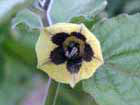 The GOLDENBERRY grows about 1.2 metres tall and prefers a position in full sun or light shade. Do not give it too rich a soil otherwise it will put on lots of growth but produce very little fruit. This fruit is about 2cm in diameter and the plant conveniently wraps each fruit up in its own paper bag - and then changes the colour of the bag from green to brown to let you know the fruit is ready to eat. The flavour is very rich and quite unique, some people detect a gooseberry-like quality in the flavour, though I cannot say that I have noticed this. Most people love it, though there are a few who absolutely loathe it! There is a cultivar, called 'Edulis', that has somewhat larger fruits though we find the flavour to be inferior.
The GOLDENBERRY grows about 1.2 metres tall and prefers a position in full sun or light shade. Do not give it too rich a soil otherwise it will put on lots of growth but produce very little fruit. This fruit is about 2cm in diameter and the plant conveniently wraps each fruit up in its own paper bag - and then changes the colour of the bag from green to brown to let you know the fruit is ready to eat. The flavour is very rich and quite unique, some people detect a gooseberry-like quality in the flavour, though I cannot say that I have noticed this. Most people love it, though there are a few who absolutely loathe it! There is a cultivar, called 'Edulis', that has somewhat larger fruits though we find the flavour to be inferior.
Climbing Plants:
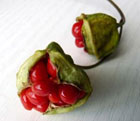 Bomarea edulis
Bomarea edulis
This is a beautiful twining herbaceous plant that will produce its flowers from early summer until late into the autumn. As an extra bonus it will also produce a crop of edible tubers with a very mild flavour. Whilst they can be used like potatoes, they are possibly best dried then grated into a powder and used like arrowroot.
Holboellia latifolia
 This twining plant produces strongly scented flowers in the spring, followed by purple fruits that can be 10cm long. It is easily grown in a fertile soil and prefers to be in part shade. This species can be grown outdoors in the milder areas of the country, tolerating temperatures that occasionally fall to -10°c, but is more likely to fruit when two different plants are grown in a conservatory and the flowers are hand-pollinated. The large purple fruit is sausage-shaped with many black seeds in the white pulp It has a mealy texture and is often considered to be insipid, though it is considered to be very palatable by others.
This twining plant produces strongly scented flowers in the spring, followed by purple fruits that can be 10cm long. It is easily grown in a fertile soil and prefers to be in part shade. This species can be grown outdoors in the milder areas of the country, tolerating temperatures that occasionally fall to -10°c, but is more likely to fruit when two different plants are grown in a conservatory and the flowers are hand-pollinated. The large purple fruit is sausage-shaped with many black seeds in the white pulp It has a mealy texture and is often considered to be insipid, though it is considered to be very palatable by others.
Passiflora species
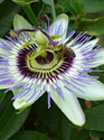 There are several species of PASSION FLOWERS that grow very well in a conservatory. With their large and exceedingly attractive flowers and rather ornamental fruits, these evergreen twining plants will look good all year round. It is important to give them a well-drained soil and you might need to hand-pollinate the flowers in order to ensure fruit is produced. Of the species most worth growing for their fruit, we would recommend the following:-
There are several species of PASSION FLOWERS that grow very well in a conservatory. With their large and exceedingly attractive flowers and rather ornamental fruits, these evergreen twining plants will look good all year round. It is important to give them a well-drained soil and you might need to hand-pollinate the flowers in order to ensure fruit is produced. Of the species most worth growing for their fruit, we would recommend the following:-
- P. actinia. Thie fruit has a very fragrant pulp.
- P. edulis. Often cultivated commercially, the fruit is about 5cm in diameter and has a flavour somewhat like an orange with a mixture of acid.
- P. membranacea. The fruit is up to 9cm long and is sweet and well flavoured.
- P. mollisima. One of the most highly prized fruits of the genus, they can be up to 15cm long and weigh 50 - 150g each.
Stauntonia hexaphylla
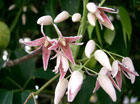 Growing maybe 10 metres tall in the wild, this evergreen twining plant flowers in the spring and will fill the air with a sweet perfume at this time. Give the plant a humus-rich but well-drained compost, placing the pot in a shady position but allowing the pant to grow into the light. Plants are dioecious, that is each plant bears only male or female flowers. This means that in order to obtain fruit you really need one male plant for every 5 - 6 females, though females have been known to bear fruit at times in the absence of a male pollinator. Hand pollination will almost certainly improve fruit set. The fruit is up to 5cm long and can be eaten raw or cooked. It is sweet but watery and has a honey-like flavour. It is highly esteemed as a dessert fruit in Japan.
Growing maybe 10 metres tall in the wild, this evergreen twining plant flowers in the spring and will fill the air with a sweet perfume at this time. Give the plant a humus-rich but well-drained compost, placing the pot in a shady position but allowing the pant to grow into the light. Plants are dioecious, that is each plant bears only male or female flowers. This means that in order to obtain fruit you really need one male plant for every 5 - 6 females, though females have been known to bear fruit at times in the absence of a male pollinator. Hand pollination will almost certainly improve fruit set. The fruit is up to 5cm long and can be eaten raw or cooked. It is sweet but watery and has a honey-like flavour. It is highly esteemed as a dessert fruit in Japan.
The above list is a selection of some of the most interesting edible plants that can be grown in greenhouses and conservatories. We can supply several but by no means all of the plants included above. If you wish to grow any of them and are unsure where to obtain them then we suggest that you obtain a copy of 'The Plant Finder'. This book, published annually by the Royal Horticultural Society, lists over 60,000 plants and the nurseries in Britain that supply them.
Database
The database has more details on these plants: Abelmoschus esculentus, Allium tuberosum, Aloe vera, Aloysia triphylla, Azorina vidalii, Bomarea edulis, Canna indica, Cyphomandra betacea, Eriobotrya japonica, Ficus carica, Holboellia latifolia, Musa acuminata, Physalis peruviana, Prunus persica, Punica granatum, Solanum muricatum, Stauntonia hexaphylla, Stevia rebaudiana, Vitis vinifera.